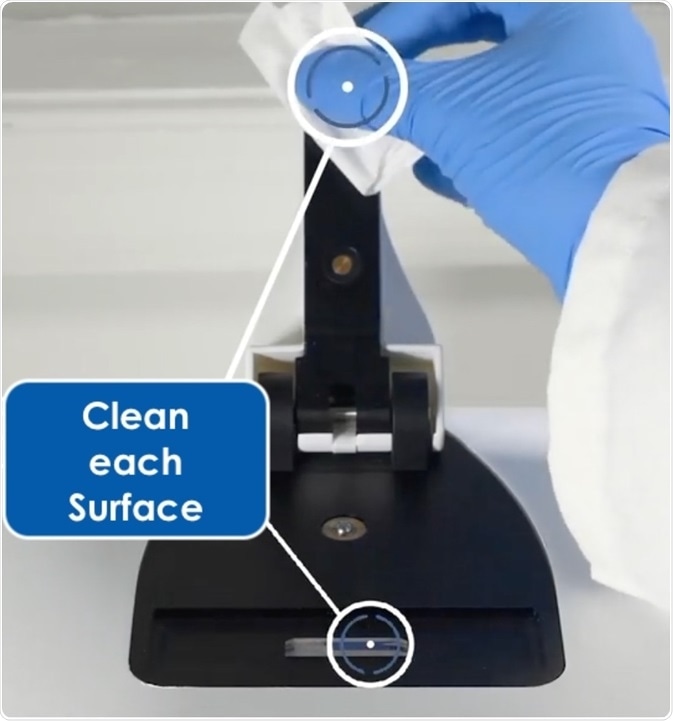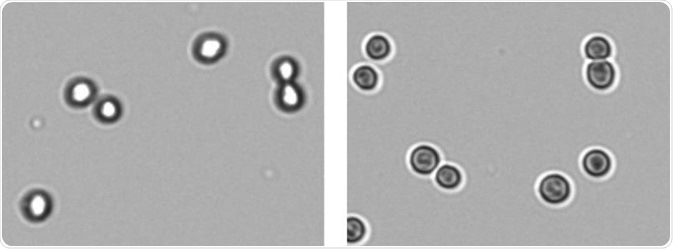Viability measurements and cell counting are key factors across an extensive array of research applications relative to a variety of diverse sample types.
This article offers seven top tips and ways to improve accuracy and ensure reproducible results when counting cells, whether manually or by employing automated systems, for example, the CellDrop™ Automated Cell Counter.
Eliminate Costs | Automate Cell Counting
1. Clean the sample surface
Ensuring a clean sample surface is crucial when conducting any cell counting method, as any contamination can produce inaccurate results.
Manual cell counting requires removing and cleaning the glass coverslip and using 70% ethanol cleansing to clean the counting chambers, followed by rinsing with water. A new slide is needed for each sample (or pair of samples if the slide has two chambers) when using disposable plastic slides.
With CellDrop Series instruments, the chamber forms between a pair of optical-grade sapphire surfaces placed in parallel to one another. The sample is pipetted between the surfaces and is fixed in place by surface tension. Simply wipe the surface with a dry laboratory wipe to clean (Figure 1).

Figure 1. Clean upper and lower sample surfaces with a dry, lint-free laboratory wipe. Image Credit: DeNovix Inc.
2. Mix immediately before loading
It is critically important to mix cell suspensions immediately before loading in order to ensure the assayed sample is fully representative (Figure 2).
Cells of varying sizes and types will aggregate and settle at differing rates. Mixing the solution just prior to loading the sample ensures that the aliquot will be homogenous and accurately reflect the cell culture’s properties.
3. Minimize cell clumping
Cell counting necessitates the evaluation of a small sample of the whole stock solution, so due care and attention must be paid to ensure that the sample is representative of the original stock culture.
While cell counters like CellDrop identify individual cells within clumps by the application of sophisticated software algorithms, they do not have the capacity to correct for a non-representative sample. When manually counting, user-to-user variability is more likely as clumps are often scored more subjectivity than individual cells.
Clumping is often caused by extracellular DNA and cell debris following cell lysis. Cell lysis may result from factors such as overgrowth, freeze/thaw cycles, mechanical shearing through too much pipetting, and under- or over-digestion with trypsin can also give rise to heterogeneous samples.
By preventing the causes of cell lysis and filtering samples for cell debris, cell clumps can be significantly reduced.
4. Optimize settings
Whether relying on software algorithms or counting by hand, it is just as important to modify the focus and exposure settings to ensure the optimal visibility of cells for the most accurate results.
Focus and exposure should be optimized to show a sharp contrast between the cell membrane and the background (Figures 2 and 3).
For fluorescence applications, possessing the capacity to optimize each fluorescence channel individually will yield the most reproducible results. Fluorescence intensities should be configured to ensure that the cells are at the brightest possible level while maintaining their true size. No light should bleed over the edges of the cells.

Figure 2. Optimal Focus. Correct focus (left) and poorly focused image (right). Image Credit: DeNovix Inc.

Figure 3. Exposure. Correct exposure (left), overexposed (center), underexposed (right). Image Credit: DeNovix Inc.
5. Use an appropriate chamber height
With a range of hemocytometers available, each of which varies in depth and grid design, be sure to take care that the right details are used when making calculations to avoid errors.
The CellDrop has a novel feature that enables a greater range of cell density than other slide-based counters. The loading chamber height can be adjusted to various depths to accept more or less sample. This allows control of the number of cells on the measurment surface and avoiding time-consuming dilution or centrifugation steps.
On-screen guidance is provided to ensure optimal height and calculations are adjusted automatically.
6. Adjust counting parameters
Most automated cell counters include settings that can be corrected to best match the cells being evaluated. For instance, cell size ranges can be set and saved for the purpose of excluding debris or other cell populations from analysis.
Settings to define cell shape are also available. In the case of the CellDrop, settings can be adjusted before or after the cells have been counted, and the data will be reanalyzed according to the new parameters.
7. Choosing brightfield or fluorescence
Brightfield analysis can be a useful tool for quantifying cultured mammalian cells in culture. However, it can be difficult to differentiate between live and dead cells only applying trypan blue, and for many primary cells or counting isolated nuclei, fluorescence may be a more accurate method.
For instance, peripheral blood mononuclear cells (PBMCs) are typically mixed with large numbers of red blood cells (RBCs) that may appear to be “dead” using brightfield analysis.
However, with dyes such as acridine orange (AO) and propidium iodide (PI), it is possible to stain only nucleated PBMCs in isolation and differentiate live, dead and non-nucleated cells or debris by way of using dual fluorescence capabilities.
AO and PI both stain nucleic acids, but only AO has the capacity to penetrate live cell membranes. Consequently, live PBMCs are stained with AO and fluoresce green; dead PBMCs are stained with both AO and PI and fluoresce red. RBCs and debris remain unstained and display no fluorescence at all.
Summary
Following these seven tips will help to boost cell counting accuracy and reproducibility. For additional information, watch the webinar below or contact the DeNovix applications team.
Webinar: 7 tips for improving cell counting accuracy
7 Tips | Improving Cell Counting Results
Video Credit: DeNovix Inc.
About DeNovix, Inc.
WELCOME TO DENOVIX
Award-Winning products for Life Science
Our multi-award winning products include the Reviewers’ Choice Life Science Product of the Year and Platinum Seal awarded- DS-11 Series Spectrophotometer / Fluorometer and CellDrop™ Automated Cell Counter. CellDrop is the first instrument of its kind to Count Cells Without Slides. These powerful instruments integrate patented DeNovix technology with easy-to-use software designed by life scientists for life scientists.
Researchers tell us they love the industry leading performance, smart-phone-like operation, and the flexible connectivity of the instruments. When support is needed, the DeNovix team is here to help. DeNovix received the prestigious Life Sciences Customer Service of the Year based on independent reviews posted by scientists worldwide!
CellDrop: Sustainable laboratory product of the year
The CellDrop Automated Cell Counter has been awarded Sustainable Laboratory Product of the Year in the SelectScience® Scientists’ Choice Awards®!
CellDrop’s patented DirectPipette™ technology distinguishes it as the only cell counter to eliminate the need for cell counting slides. This innovation saves millions of single-use plastic slides from use and disposal each year.
Sponsored Content Policy: News-Medical.net publishes articles and related content that may be derived from sources where we have existing commercial relationships, provided such content adds value to the core editorial ethos of News-Medical.Net which is to educate and inform site visitors interested in medical research, science, medical devices and treatments.